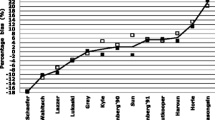Abstract
This article compares the determination of body fat-free-mass (FFM) by impedance, using either hand-to-foot resistance (R13) or foot-to-foot one (R34) from comparison with dual X-ray absorptiometry (DXA) measurements in a normal population. The first goal was to see if the foot-to-foot resistance used in body fat analysers provides less accurate information for body FFM than the hand-to-foot one used by medical impedance-meters. Another goal was to compare the prediction accuracy of six different regression equations of FFM for each sex and for each resistance relatively to DXA. The impedancemeter used in this study was a Tefal prototype with 4 plantar electrodes and 4 additional electrodes for the hands and providing hand-to-foot and foot-to-foot resistances. Coefficients of these correlations were determined by comparison with FFM measured by DXA in a 1st cohort of 170 healthy adults. For an independent validation, these equations were tested in a 2nd cohort of 86 adults who underwent the same impedance and DXA protocols, using Student’s paired t-tests. The accuracy of FFM prediction increased generally with the number of physiologic parameters included in the regression, but none of our equations gave FFM predictions significantly different from DXA. FFM calculated from the foot-to-foot resistance were closer to DXA values than those calculated from hand-to-foot resistance, as their average P-value of comparison with DXA was higher at 0.695 against 0.387 for R13.






Similar content being viewed by others
Abbreviations
- BIS:
-
Bioimpedance spectroscopy
- BMI:
-
Body mass index (kg m−2)
- DXA:
-
Dual X-ray absorptiometry
- FFI:
-
Foot-to-foot impedancemeter
- FFM:
-
Fat-free mass
- FM:
-
Fat tissue mass
- SD:
-
Standard deviation
- H:
-
Subject height (m)
- R13 :
-
Hand-to-foot resistance (Ω)
- R34 :
-
Foot-to-foot resistance (Ω)
- W:
-
Body weight (kg)
- X:
-
Reactance (Ω)
- d:
-
DXA
- i:
-
Impedance
References
Bland JM, Altman DG (2000) Measuring agreement in method comparison studies. Stat Method Med Res 8:135–160
Boulier A, Chumlea WC, De Lorenzo A, Deurenberg P, Guo SS, Leger L, Schutz Y (2005) Body composition estimation using leg-to-leg bioelectrical impedance: a six-site international cross validation study. Int J Body Composition Res 3:31–39
Buchholz AC, Bartok C, Schoeller DA (2004) The validity of bioelectrical impedance models in clinical populations. Nutr Clin Pract 19:433–446
De Lorenzo A, Andreoli A, Matthie JR, Withers P (1997) Predicting body cell mass with bio-impedance by using theoretical methods: a technological review. J Appl Physiol 82:1542–1558
Gibson AL, Holmes JC, Desautels RL, Edmonds LB, Nuudi L (2008) Ability of new octapolar bioimpedance spectroscopy analysers to predict 4-component-model percentage body fat in Hispanic, black and white adults. Am J Clin Nut 87:332–338
Jaffrin MY, Morel H (2009) Measurements of body composition in limbs and trunk using a eight contact electrodes impedancemeter. Med Eng Phys 31:1079–1086
Jaffrin MY, Morel H (2009) Extracellular volume measurements using bioimpedance spectro-scopy-Hanai method and wrist-ankle resistance at 50 kHz. Med Biol Eng Comput 47(1):77–84 PMID: 18797950
Jaffrin MY, Kieffer R, Moreno MV (2005) Evaluation of a foot-to-foot impedance meter measuring extracellular fluid volume in addition to fat-free mass and fat tissue mass. Nutrition 21:815–824
Jaffrin MY, Fenech M, Moreno MV, Kieffer R (2006) Total body water measurement by a modification of the bioimpedance spectroscopy method. Med Biol Eng Comput 44:873–882
Kyle UG, Genton L, Karsegard L, Slosman DO, Pichard C (2001) Single prediction equation for bioelectrical impedance analysis in adults aged 20–94 years. Nutrition 17:248–253
Kyle UG, Bosaeus I, De Lorenzo AD, Deurenberg P et al (2004) Bioelectrical impedance analysis-part I: review of principles and methods. Clin Nutr 23:1226–1243
Lukaski HC, Siders WA (2003) Validity and accuracy of regional bioelectrical impedance devices to determine whole-body fatness. Nutrition 19:851–857
Medrano G, Eitner F, Walter M, Leonhardt S (2010) Model-based correction of the influence of body position on continuous segmental and hand-to-foot bioimpedance measurements. Med Biol Eng Comput 48:531–541 PMID: 20405231
Neovius M, Udden J, Hemmingsson E (2007) Assessment of change in body fat percentage with DXA and eight-electrode BIA in centrally obese women. Med Sci Sports Exerc 39:2199–2203
Nunez C, Gallagher D, Visser M, Pi-Sunyer FX, Wang Z, Heymsfield SB (1997) Bioimpedance analysis: evaluation of leg-to-leg system based on pressure contact foot-pad electrodes. Med Sci Sports Exerc 29:524–531
Organ LW, Bradham GB, Gore DT et al (1994) Segmental bioelectrical impedance analysis: theory and application of a new technique. J Appl Physiol 77:98–112
Sun SS, Chumlea WC, Heymsfield SB, Lukaski HC et al (2003) Development of bioelelctrical impedance analysis prediction equations for body composition with the use of a multicomponent model for use in epidemiologic surveys. Am J Clin Nutr 77:331–340
Utter AC, Nieman DC, Ward AN, Butterworth DE (1999) Use of leg-to-leg bioelectrical impedance method in assessing body-composition change in obese women. Am J Clin Nutr 6:603–607
Wotton MJ, Thomas BJ, Cornish BH, Ward LC (2000) Comparison of whole body and segmental bioimpedance methodologies for estimating total body water. Ann NY Acad Sci 904:181–186
Acknowledgments
The authors acknowledge the cooperation of the Centre d’Imagerie Médicale Avancée (CIMA) of Compiègne for DXA measurements and the supply of a prototype impedance-meter by Tefal SAS.
Author information
Authors and Affiliations
Corresponding author
Rights and permissions
About this article
Cite this article
Bousbiat, S., Jaffrin, M.Y. & Dongmo, E. Comparison of body fat-free masses calculated from hand-to-foot and foot-to-foot resistances with DXA measurements. Med Biol Eng Comput 49, 1329–1336 (2011). https://doi.org/10.1007/s11517-011-0827-y
Received:
Accepted:
Published:
Issue Date:
DOI: https://doi.org/10.1007/s11517-011-0827-y




